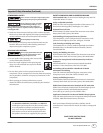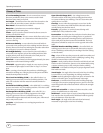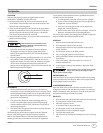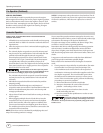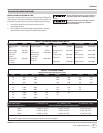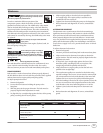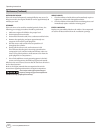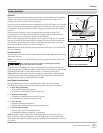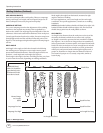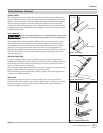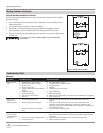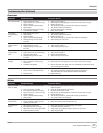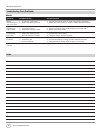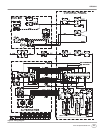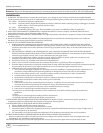
GR3000
www.campbellhausfeld.com
17
Troubleshooting Chart (Continued)
Generator
Symptom Possible Cause(s) Corrective Action
No output voltage 1. Engine speed is too slow
2. Open, shorted, or incorrect wiring
3. Faulty capacitor
4. Open or shorted field windings
5. Open diodes
6. Front panel switch set incorrectly
7. Circuit breaker tripped
1. Adjust engine speed H
2. Referring to the wiring diagram, clean and reconnect all wiring H
3. Replace capacitor H
4. Test winding resistance, replace field winding if necessary H
5. Test diodes, replace if necessary H
6. Set front panel switch to generator
7. Reset circuit breaker
Low output
voltage with no
load
1. Engine speed is too slow
2. Open diodes
3. Faulty capacitor
4. Open or shorted field windings
5. Voltage setting on front panel
incorrect
1. Adjust engine speed H
2. Test diodes, replace if necessary H
3. Replace capacitor H
4. Test winding resistance, replace field winding if necessary H
5. Adjust setting on front panel
High output
voltage with no
load
1. Faulty capacitor
2. Engine speed is too fast
3. Voltage setting on front panel
incorrect
1. Replace capacitor H
2. Adjust engine speed H
3. Adjust setting on front panel
Low output
voltage under
load
1. Open diode
2. Engine speed too slow at full load
3. Excessive load applied
4. Voltage setting on front panel
incorrect
1. Test diodes, replace if necessary H
2. Adjust engine speed H
3. Reduce the applied load
4. Adjust setting on front panel
Erratic output
voltage
1. Unbalanced engine
2. Dirty, corroded, or loose wiring
connection
3. Unstable load applied
1. Refer to engine manual
2. Referring to the wiring diagram, clean and reconnect all wiring H
3. Remove all loads, then apply each one individually to determine which
one is causing erratic function
Noisy operation 1. Loose unit or engine bolt (s)
2. Short circuit in unit field or load
3. Faulty bearing
1. Tighten all mountings
2. Test winding resistance, replace field winding if necessary H
Test load devices for shorts. Replace defective load device.
3. Replace bearing
H These diagnostic and repair procedures should be performed by an authorized service center.
Welder
Symptom Possible Cause(s) Corrective Action
Welder runs but
does not weld
1. Inadequate current at electrode
2. Poor connections at welder
3. Front panel switch set incorrectly
4. Open, shorted, or incorrect wiring
5. Faulty capacitor
6. Open or shorted field windings
7. Open diodes
1. Check work clamp, cable and connection to work piece. Check electrode
cable and clamp
2. Check all welder external connections
3. Set front panel switch to weld
4. Referring to the wiring diagram, clean and reconnect all wiring H
5. Replace capacitor H
6. Test winding resistance, replace field winding if necessary H
7. Test diodes, replace if necessary H
Welder gives
trickle shocks
1. Accidental contact with work piece
2. Current leakage caused by moist
clothing or work area
1. Avoid contact with work piece
2. Make sure clothing and work area are dry
Arc difficult to
strike
1. Wrong type of electrode.
2. Electrode diameter too large
3. Work piece not properly grounded
4. Engine speed is too slow
1. Verify that electrode is for alternating current (AC)
2. Use smaller diameter electrode
3. Verify proper grounding. (No paint, varnish or corrosion)
4. Adjust engine speed
H These diagnostic and repair procedures should be performed by an authorized service center.



